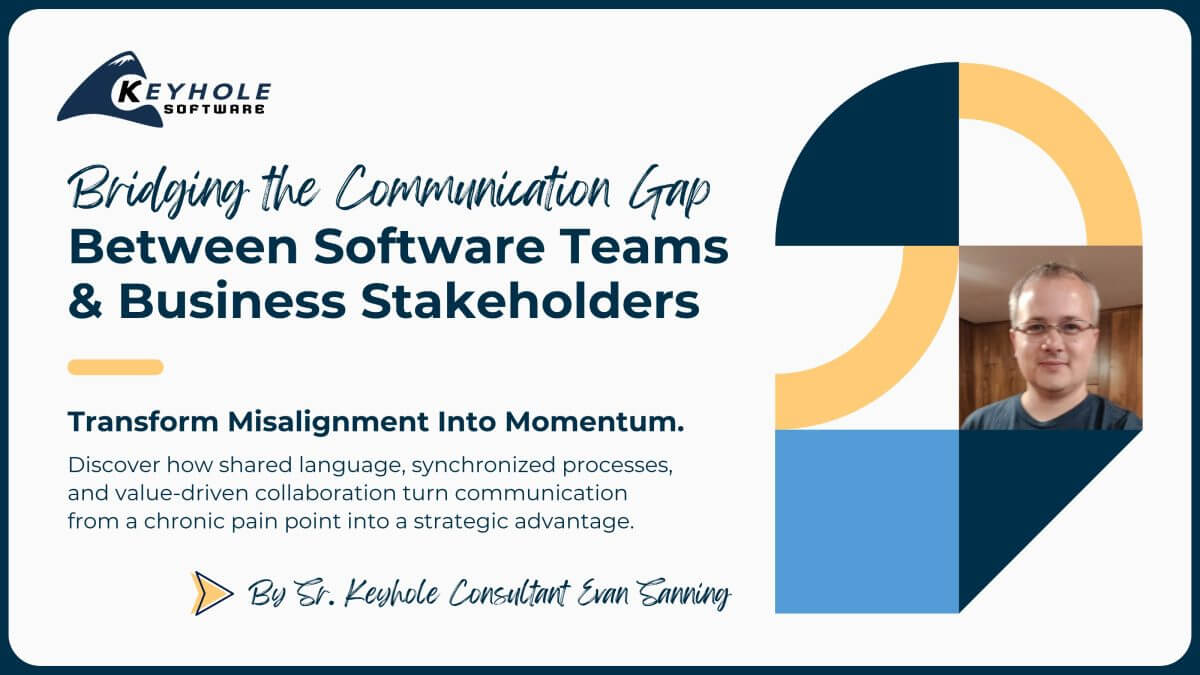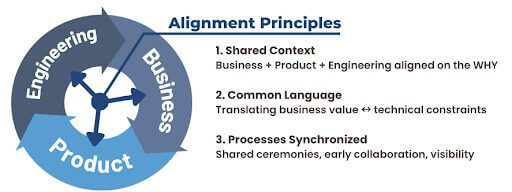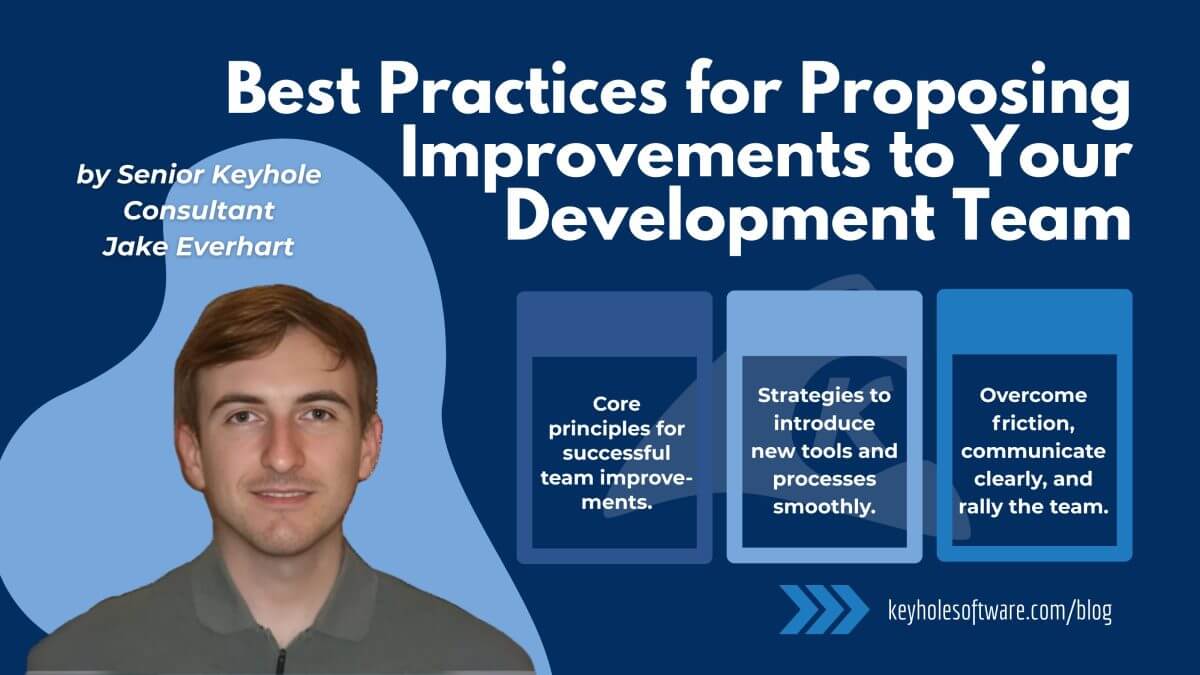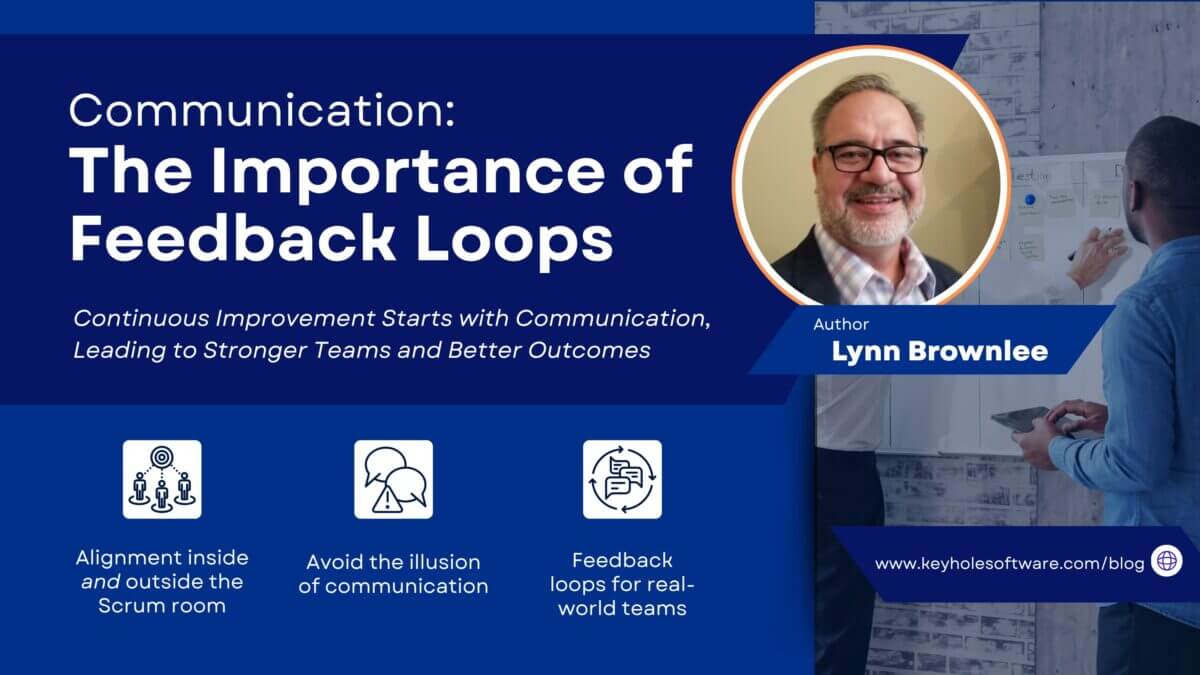
Bridging the Communication Gap Between Software Teams and Business Stakeholders
November 20, 2025
Technical and non-technical teams often share an office, sit in the same meetings, and work toward the same goal, but still struggle to communicate. The real issue isn’t missing words, but failing to agree on their true meaning and worth. While the tech side discusses things like latency and architecture, the other side only understands costs, delays, and customer impact. When those vocabularies don’t connect, the organization pays for it in rework, missed opportunities, and unnecessary delays.
Bridging this communication gap starts with translating technical decisions into clear business value and giving both sides a shared language of value that everyone understands.
In this blog, we’ll break down the cost of miscommunication between software development teams and business stakeholders, explain why this gap keeps showing up, and share practical ways teams can create better alignment and collaborate more effectively.
The Organizational Cost of Miscommunication
Miscommunication between technical and non-technical teams imposes severe organizational costs that manifest as direct drains on resources and efficiency.
For Software Development Teams: Wasted Effort and Technical Debt
For technical teams, the main cost is wasted effort. Vague, incorrect, or shifting requirements force software engineers into continuous rework, requiring them to discard completed code, redesign complex systems, and interrupt deep work to clarify instructions.
For instance, management decided to migrate the application to a new authentication service. They supplied the vendor’s solution and a hard deadline, but did not involve business users or the dev team in the decision. When starting the implementation of the new method, questions arose about certain aspects of the use of user experience—yet we were told the vendor’s package had already been chosen, so work proceeded. The product turned out to be less fully featured than expected, meaning we had to make compromises around branding of the sign-in page and user workflows to fit into our web app. By the time the bulk of the integration was complete, the business had already shifted its strategy: users would no longer log in with the traditional credentials at all but would instead be linked directly to their patient accounts.
This constant context switching leads to substantial momentum loss and often results in hurried implementation choices that create costly technical debt—future maintenance burdens that increase costs and slow development velocity.
For Business Teams: Missed Opportunities and Budget Overruns
For non-technical teams and business stakeholders, the costs show up in missed opportunities, blown timelines, and budget impact. Project delays, caused by the technical team’s rework, can cause the organization to miss critical market windows, allowing competitors to gain a competitive edge and sacrificing potential revenue.
Furthermore, all the extra time spent fixing initial misunderstandings translates directly into significant unplanned budget overruns, consuming funds intended for other high-value initiatives.
The External Cost: Customer Trust
Ultimately, internal misalignment becomes an external problem. These internal costs converge into a single external consequence: a damaged reputation. When the delivered product fails to meet the expected business need or contains quality flaws traceable to poor communication, it leads directly to eroded customer trust, increased support ticket volumes, and a perception that the organization cannot reliably execute its goals.
It goes without saying, but no one wants this outcome; not the software development team creating the application, and not the business stakeholders beholden to the bottom line!
Why the Gap Still Exists
In my experience, the divide between software development teams and non-technical teams grows gradually from deeply entrenched habits, different operating languages, and fragmented processes that naturally pull teams apart.
Different Languages
One of the primary barriers is different vocabularies.
- Software Engineers use technical shorthand like latency, CI/CD, refactoring, and service accounts.
- Business teams talk about Customer Acquisition Cost (CAC), conversion, churn, margins, and customer experience.
- Product teams often sit in the middle of these two vocabularies, but without shared definitions, they end up translating imperfectly between both sides.
This specialization means that when a new concept is introduced, discussion stalls because a shared definition is missing. Without shared definitions, both sides rely on assumptions:
- Developers assume business leaders understand technical constraints.
- Business stakeholders assume engineers grasp the market or customer nuance.
This leads to decisions built on misalignment rather than clarity.
Different Incentives and Scorecards
This linguistic disconnect is reinforced by fundamentally misaligned incentives.
- Software developers and technical teams often prioritize internal metrics like code quality, test coverage, reliability, scalability or deployment frequency.
- Business leaders prioritize external results such as revenue, timelines, customer satisfaction, and market share.
- Product teams frequently have to reconcile these competing priorities, which increases the cost of misalignment when the incentives don’t line up.
When each side is measured by a different scorecard, they naturally prioritize what rewards them—even when those optimizations unintentionally create friction for the other side.
Siloed Processes
These forces are amplified by siloed processes.
- Development teams conducts stand-ups, backlog grooming, sprint planning, and retrospectives, while
- Product and business leaders plan roadmaps and product strategy or perform design reviews in separate forums.
When critical decisions are made in isolated rooms, the ripple effects are not fully understood by everyone impacted. When decisions are made in isolation, teams lack visibility into trade-offs and constraints, preventing a shared narrative that effectively links the why (customer value) to the what (technical solution).
When Engineers Don’t Have Business Context
Without a clear grasp of the organization’s strategic agenda, engineering teams risk building features that are technically sound but market failures, resulting in significant wasted investment.
Feature Creep and Technical Exploration
When developers lack the “why” behind the “what,” they often fall into wrong-direction feature creep. They prioritize showcasing new technology or solving complex technical puzzles over addressing core customer problems, needlessly inflating the project scope without delivering proportionate business value or revenue impact.
UX Neglect
A focus on technical architecture alone can overshadow user experience. When usability is deprioritized, customers encounter friction. Think of things like confusing flows, slower performance, or features that don’t align with real needs. This ultimately increases dissatisfaction and churn.
ROI Blind Spots
This lack of business context creates substantial ROI blind spots. Teams may champion large-scale refactoring, investing significant sprint time in modernizing frameworks or improving performance, treating the effort as a win simply because it’s technically superior.
But without connecting the investment to measurable business impact (cost savings, reduced outages, improved conversion), your development team risks spending significant time on work that doesn’t advance the business side’s long-term strategy.
Misaligned Prioritization
However, this investment becomes costly if the effort is not weighed against its actual business benefit, such as clear cost savings or improved conversion rates. The tragic result is misaligned prioritization, where revenue-driving features are delayed while resources are consumed by tasks that look good on a technical scorecard but have no measurable impact on the bottom line.
To fix this, every technical decision must always be tied to value, impact and business outcomes. Engineering teams must integrate key business metrics like churn, CAC, and Average Order Value (AOV) directly into their sprint planning.
By attaching every backlog item to a measurable business outcome, and requiring product and engineering roles to pair up on critical features, technical decisions shift from building “nice-to-have” internal projects to delivering features that demonstrably improve user experience, reduce risk, and generate revenue.
Translating Technical Concepts into Business Value
Every technical decision—from a simple code commit to a major architecture shift—must be viewed not as a purely engineering artifact, but as a strategic investment. The value of engineering work is fully realized only when it is translated into a clear business outcome.
If a developer describes a refactor solely in terms of reducing complexity, the work risks being undervalued. However, if that same refactor is framed as “shaving 250 milliseconds off checkout time to boost conversion by 3%,” the technical effort immediately gains a persuasive, business-centric language that aligns with strategic goals.
Ineffective communication is a two-way street; just as an unwritten business rule can doom a feature, so can a solution that fails to meet user needs due to a lack of clear articulation. The key to successful communication is to make the purpose, risk, and impact of any technical undertaking instantly understandable to a non-technical audience. The following table provides examples for translating common technical statements into their corresponding business value.
| Technical Statement | Business Value Translation |
|---|---|
| “We need to refactor the ‘ABC application’.” | “We need to clean up the ABC application so it runs faster and more reliably, and so new features can be added more easily—reducing long-term maintenance costs.” |
| “We are increasing server capacity for peak load.” | “We are ensuring our system stays responsive during high-traffic events (like sales or product launches) so customers don’t experience failures—protecting revenue.” |
| “We are implementing a microservices architecture.” | “We are implementing a new system built with independent components, meaning we can update one feature without risking the stability of the entire platform—reducing downtime risk and accelerating delivery of new enhancements.” |
| “The ‘ABC application’ has a lot of technical debt.” | “The application’s structural issues make adding new features difficult & risky. Fixing these long-term issues now prevents costly outages and security issues that could compromise the business later.” |
| “All applications going forward will implement CI/CD.” | “Future application changes will be automatically reviewed, tested, and deployed. This speeds up delivery, reduces errors, and makes releases far more reliable.” |
| “MFA will be required for all administrative logins to enhance security.” | “Administrative access will now require additional verification. In addition to a normal password (something they know), they will also receive a one-time code to a device they own (something they have) or a biometric verification (something they are), making it far harder for unauthorized users to break in and reducing security risk.” |
Practical Ways to Close the Communication Gap
Closing the expensive communication gap requires intentional, structural changes that foster a shared language and synchronized objectives. It’s not enough to simply encourage “better communication”—teams need lightweight, repeatable practices that make clarity the default, not the exception. Even small adjustments can create immediate improvements, especially when adopted consistently.
1. Create shared context
The most effective step is to eliminate siloed knowledge by aligning every conversation around why the work matters.
Non-technical teams should make it mandatory to attach every request to a measurable business outcome—the why. Instead of asking for “more security,” ask for “measures to reduce customer data breach risk by X% to protect our compliance rating.”
Conversely, engineering teams should translate technical work into business language that connects to risk, cost, and customer impact.
Takeaway (Implement Today):
- Require every request or user story to include a measurable business goal.
- Add a “Why this matters” field to Jira tickets or PRDs.
- Start sprint planning with a 2-minute restatement of business priorities.
- Encourage engineers to ask clarifying questions like: “What outcome does this enable?”
- Have developers include a one-sentence business value summary in pull requests.
2. Establish a common language
This means consistently using analogies, visual diagrams, and cost-benefit frameworks (“This fix is high effort but prevents a high-risk failure”) to explain complex concepts, eliminating jargon from discussions that combine software development team members with people from the business side of the house.
Takeaway (Implement Today):
- Replace jargon with plain-language explanations during cross-team meetings.
- Add simple architecture diagrams or screenshots to requirements.
- Use a standardized template for explaining trade-offs (Effort | Impact | Risk).
- Introduce a shared glossary of common technical and business terms.
- Use analogies when introducing new technical concepts to non-technical groups.
3. Synchronize processes
To align incentives and ensure visibility, teams need structured overlap—not more meetings, just the right ones. Invite business teams to sprint reviews, roadmap discussions, and technical demo days.
Takeaway (Implement Today):
- Invite business stakeholders to sprint reviews and release demos.
- Share early prototypes or wireframes with engineering before requirements finalize.
- Use “three amigo” sessions (Product + Engineering + Design/Business) for complex features.
- Perform a 10-minute weekly cross-functional sync to surface blockers early.
- Encourage product managers to attend stand-up once per week for awareness.
4. Adopt a value-driven development flow
A value-driven development flow is a continuous, collaborative product lifecycle where business, product, and engineering stay aligned around measurable outcomes at every stage. The goal is simple: ensure that every decision, activity, and iteration ties directly to outcomes that matter.
Instead of a one-way handoff (Business → Product → Engineering), it becomes a recurring loop of Business ↔ Product ↔ Engineering, grounded in real data rather than assumptions.
So, from this
When achieved, this development flow creates an ongoing cycle of value → build → measure → learn → value again. Every iteration starts with clear intent and ends with validated impact, reducing waste and preventing surprises.
This process, often seen in frameworks that prioritize business value, requires deliberate overlap between the technical and non-technical sides of software development. This type of loop appears in frameworks like the Dynamic Systems Development Method (DSDM), which emphasize iterative delivery and collaboration. You don’t need to adopt DSDM outright to benefit from the underlying principles—shared context, shared language, and synchronized processes throughout every stage of 1-4 in the diagram naturally lead to better outcomes.
Teams can put this into practice immediately. Engineering should actively invite Product and Business Development to key ceremonies, such as sprint reviews and release planning. This ensures non-technical stakeholders see the technical trade-offs being made and understand the real-time project status in the context of the overall value stream.
Simultaneously, non-technical teams or business stakeholders must involve a core developer early in the ideation phase to pressure-test assumptions and define technical constraints before a requirement is finalized. This continuous, two-way feedback loop replaces costly late-stage surprises with early, shared accountability.
This continuous feedback loop turns miscommunication from a chronic burden into a manageable risk.
Takeaway (Implement Today):
- Add a developer to early ideation or discovery workshops.
- Bring product leaders into architecture review sessions—at least for the first 10 minutes.
- Define “value” for each feature using a simple template (Problem → Outcome → Metric).
- Document trade-offs for major technical decisions in 3–5 bullet points.
- Require both Product and Engineering sign-off before locking scope.
“Quick Wins” to Improve Communication Today
- Add “Why this matters” to every ticket.
- Use visuals and diagrams instead of long explanations.
- Do a weekly 10-minute cross-functional sync.
- Pair Product + Engineering on defining acceptance criteria.
- Translate every major technical decision into customer or business impact.
- Use a shared glossary to unify terms across teams.
- Invite a developer to ALL early business discussions (and vice versa).
Conclusion: Communication as a Strategic Advantage
The costs of miscommunication—wasted effort, missed opportunities, and eroded trust—are not abstract; they are the tangible result of organizational drift and siloed habits. We have seen that the gap persists due to misaligned incentives and specialized language, and that bridging it requires both technical teams to articulate value in business terms, and non-technical teams to clearly define needs with measurable outcomes.
Closing this divide is not merely a matter of being “nicer” and more considerate of each other; it is a strategic imperative that directly impacts the bottom line. Effective communication must be institutionalized through shared processes, intentional translation, and a commitment to a unified purpose. For more tips on improving cross-functional team communication, check out the Keyhole Software blog.
More From Evan Sanning
About Keyhole Software
Expert team of software developer consultants solving complex software challenges for U.S. clients.







